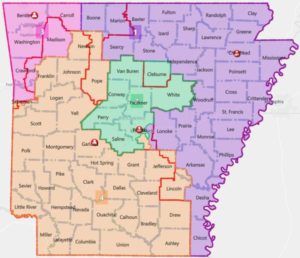Lawmakers and Little Rock’s mayor are expressing concern about drawing districts around racial lines.

The Arkansas General Assembly has approved two identical bills redrawing the state’s congressional districts. Both maps divide Pulaski County into three districts, which opponents said will have a negative impact on minority voters.
Redistricting is required by law every ten years. When new Census data is released each decade, Arkansas lawmakers must redraw the state’s congressional districts so each of the four districts meet various legal criteria such as having roughly the same population.
 The new map headed to the governor’s desk splits Little Rock between two districts and Pulaski County between three. While speaking against SB743 yesterday, Rep. Fred Love, a Democrat from Little Rock, said the map adversely impacts Black voters.
The new map headed to the governor’s desk splits Little Rock between two districts and Pulaski County between three. While speaking against SB743 yesterday, Rep. Fred Love, a Democrat from Little Rock, said the map adversely impacts Black voters.
“The impact of this map is that it’s going to disenfranchise African American communities,” Love said.
HB1982 is the companion bill to SB743 and both were sponsored by Sen. Jane English, a Republican from North Little Rock, and Rep. Nelda Speaks, a Republican from Mountain Home. On Wednesday, Sen. English said the state’s congressional district map was being redrawn simply to reflect changes in population across the state.
“I believe this is a good map and a lot of people have worked on this, not me, but a lot of people in the Senate, a lot of people in the House, and I think we’ve come up with a very good bill that we can all live with,” she said.
Little Rock Mayor Frank Scott issued a statement Thursday voicing his disapproval of the new map because it separates communities south of I-30 — predominately Black and Hispanic neighborhoods — from the rest of the city.
“I am deeply concerned about the gerrymandering along racial lines happening in our community, which was designed to dilute the voices of the residents of Little Rock,” he said.
Scott also said it was illogical to split the state’s capital city into two districts and is hopeful the Arkansas judicial system will correct the new boundaries.
Little Rock’s ward lines are also being redrawn and Mayor Scott said it’s important that decision is made with public input. Residents can share their ideas for new wards by sending an email to mayorscott@littlerock.gov. The mayor’s goals for the process include eliminating I-630 as a dividing line in the community and avoiding wards that are overwhelmingly single-race in their composition.
In addition to splitting Pulaski County between the 1st, 2nd and 4th Districts, it also splits Sebastian County between the 3rd and 4th Districts. Five counties are divided under the state’s current map.
There’s nothing wrong with dividing a county in order to achieve the correct population requirements and constitutional standards, Gov. Asa Hutchinson said during his weekly press briefing Wednesday. However, there should not be much of a population variance in each district.
“What’s important is not whether or not you divide Pulaski County, but how you divide Pulaski County if you make that decision to do so,” Hutchinson said. “I would urge them to keep in mind that you do not want to dilute minority representation or influence in congressional races.”
Both bills have been delivered to Gov. Asa Hutchinson who has five days (excluding Sunday) to sign them into law or veto them. The bills will become law automatically if he does not sign them during that time period. If he vetoes them, legislators can overturn the decision with a simple majority vote of both chambers.
The Arkansas Board of Apportionment will redraw the state’s 100 House and 35 Senate Districts this year. The board consists of Gov. Hutchinson, Secretary of State John Thurston and Attorney General Leslie Rutledge. The board was created in 1936 by Amendment 23 to the Arkansas Constitution.
More information about the redistricting process is available at www.arkansasredistricting.org.

